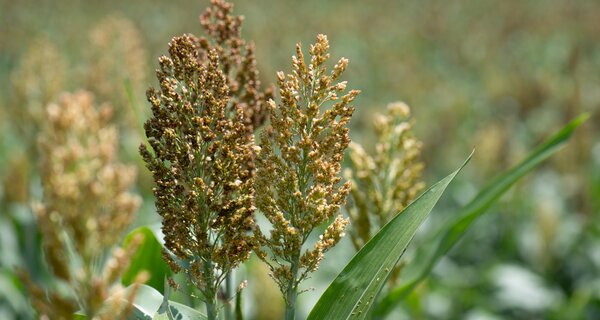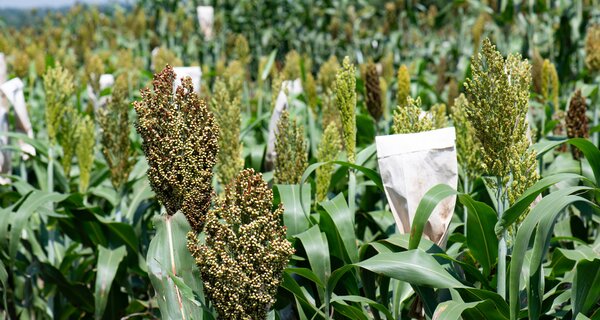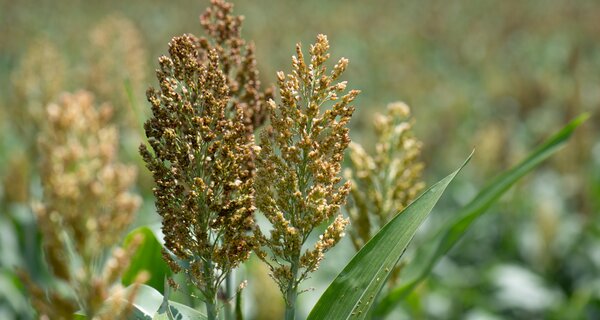Kenyan Farmers Welcome “Exotic” Sorghum
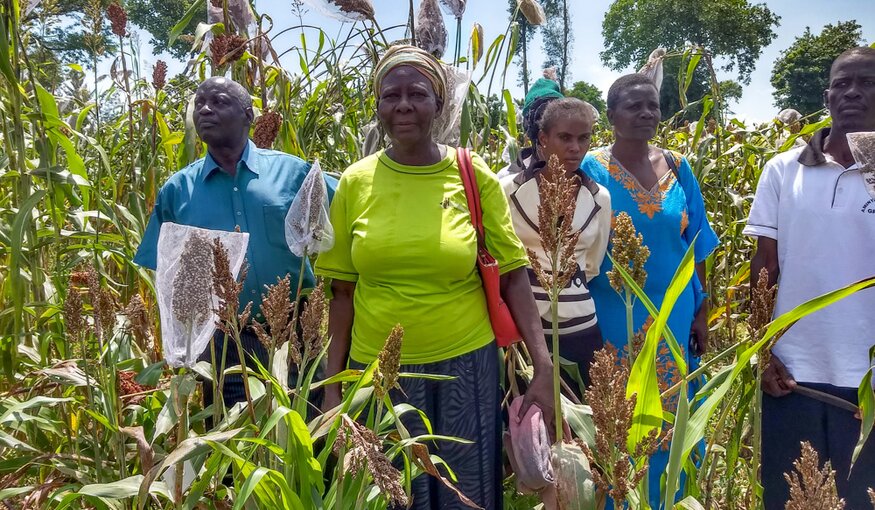 Aminyasa farmer group checking out crop wild relatives-derived sorghum lines in Migori in 2019. Photo: Eva Weltzien
Aminyasa farmer group checking out crop wild relatives-derived sorghum lines in Migori in 2019. Photo: Eva Weltzien24 January 2023
ICSWC 14RS 00020-3-47-1:201704 may be a mouthful, but to Kenyan farmers it could spell food security and better livelihood.
The alphanumeric mumbo jumbo – let’s call it Entry 588 for short – represents a sorghum plant derived by crossing a variety popular with farmers in Mali with a distant wild cousin of the crops.
Entry 588 is one of 333 sorghum lines that were evaluated in Kenya by farmers and breeders during the recently completed Crop Wild Relatives (CWR) Project. It was unlike any sorghum they had seen before, but they liked what they saw.
The project, which was coordinated by Kenya’s Rongo University and managed by the Crop Trust, sought to work with experienced sorghum farmers to explore new diversity from wild and weedy relatives of sorghum.
“Sorghum has been cultivated in the arid and semi-arid tropics of Africa for thousands of years,” said Evans Ouma, a sorghum breeder and senior lecturer at Kenya’s Rongo University. “For generations upon generations, African farmers have selected varieties to match their local conditions and food preferences. Centuries of careful observation have gone into this.”
That selection process has led to enormous diversity in farmer’s fields, but not necessarily consistently great yields. Yet, for the most part, Kenyan farmers still cultivate only a few improved varieties, which tend to be poorly adapted to the specific growing conditions in Western Kenya around Lake Victoria, where insect pests, diseases and hungry migrating birds are abundant.
“Farmers of today need sorghum that is not only high yielding but also, and perhaps more importantly, stable in yield despite climate variability,” said Evans. “But we are now measuring changes to our climate in decades. So unlike farmers in the past, who had centuries to select the current varieties, farmers today need a catalyst for faster change.”
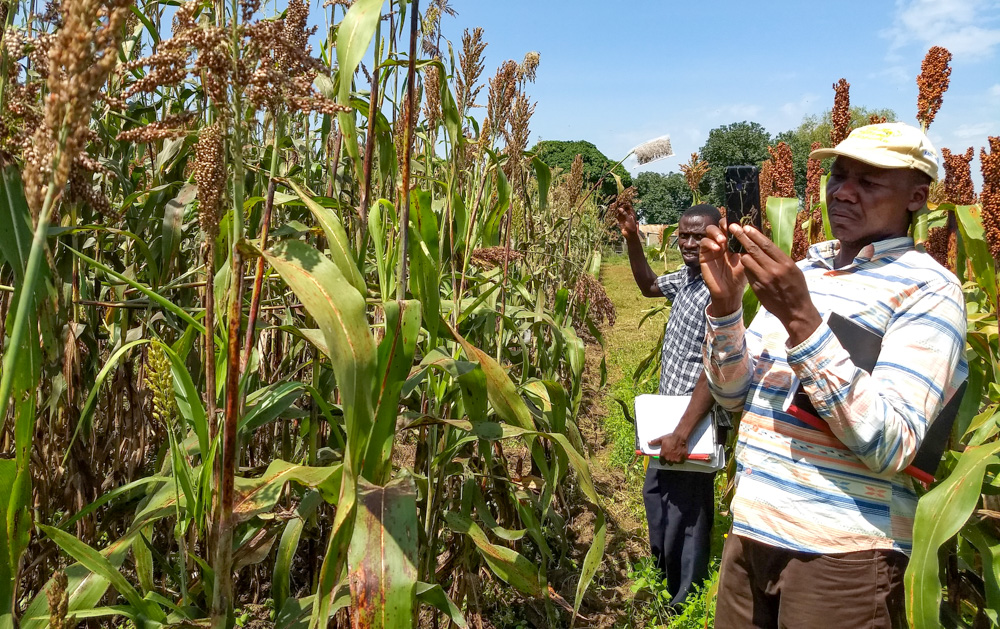
Evans Ouma and M.Sc. student Kennedy Otieno observing performance of the first progenies from crosses of sorghum with its wild relatives. Photo: Eva Weltzien
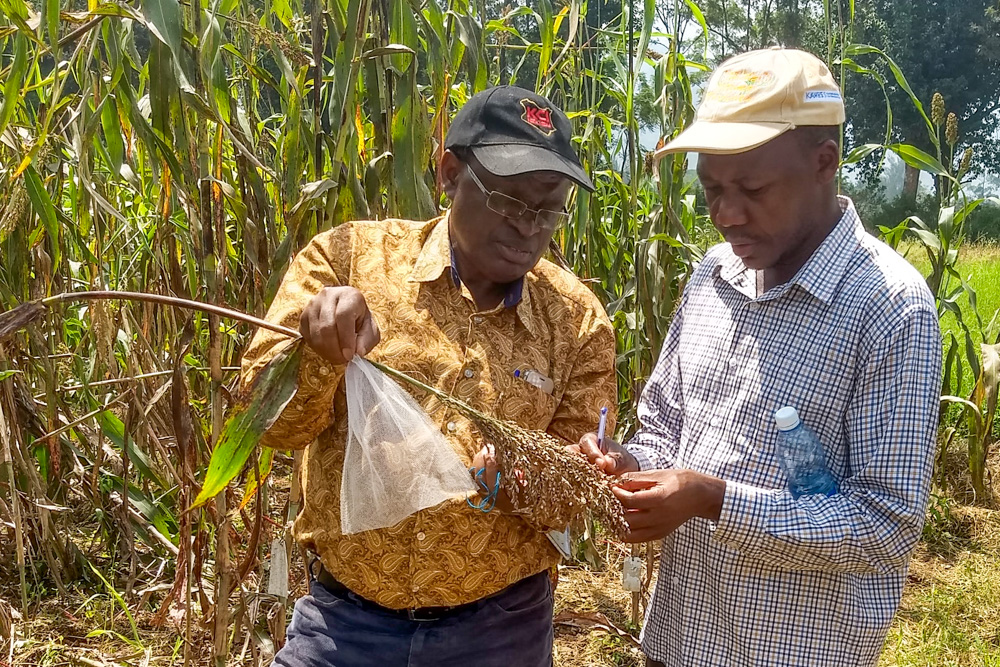
Sorghum breeders from Rongo University, Samuel Gudu (left) and Evans Ouma (right) observing a crop wild relatives-derived sorghum panicle for seed sterility at Kibos site in 2020. Photo: Eva Weltzien
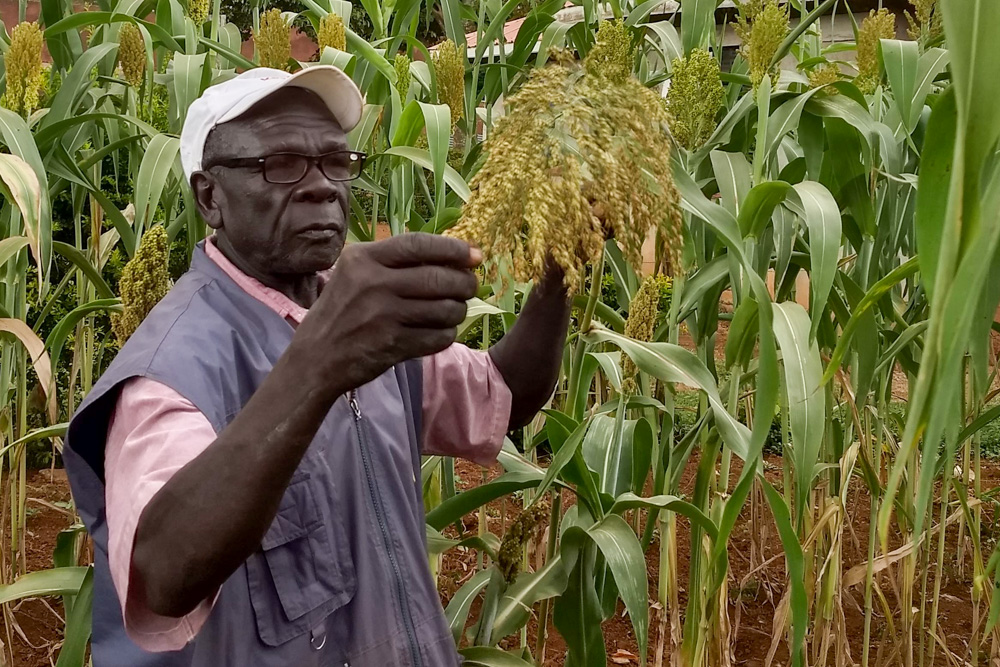
Alfred Ngesa, a farmer leader from Sega, observing a panicle of crop wild relatives-derived sorghum. Photo: Eva Weltzien
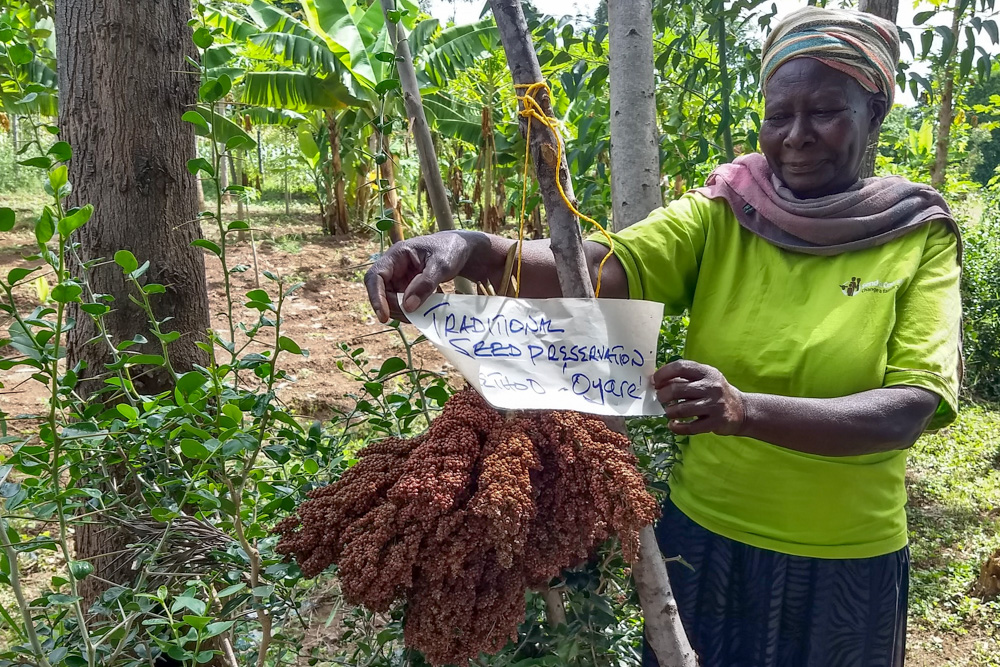
Rose Ouma, a sorghum farmer from Aminyasa, demonstrates the traditional method of storing sorghum seed. Photo: Eva Weltzien
Releasing sorghum’s wild side
Sorghum has a remarkable array of genetic variability in grain size and shape, plant type, adaptability and productive capacity. The wild cousins of sorghum hold a lot of this genetic diversity, but it is poorly known and largely untapped.
“Breeders haven’t had the time or resources to explore the genetic resources available in the wild and weedy relatives of sorghum,” said Eva Weltzien, a sorghum breeder who worked as a consultant for the project. “This project has helped breeders and farmers to explore the diversity of wild sorghum by transferring it bit by bit into cultivated types of sorghum.”
The Rongo University team received 333 different packets of seeds, each derived from crosses between weedy and cultivated sorghum from Mali to see if any could contribute to the stability of sorghum yields in faraway Kenya. Some of the sorghum came from Australia, where an initiative also funded by the CWR Project had put together a diverse collection of plants that might be of interest to breeders, while other lines came from another similar project in Mali.
In the case of Entry 588, breeders had crossed a very popular improved variety in Mali known as Jakumbé with a wild sorghum known as BBISS-09.
“BBISS-09 was collected in the very hot and dry Kayes region of northwestern Mali during collecting missions of 2004 and 2005,” explained Eva. “It has desirable traits like the stay-green character, produces many tillers, or daughter plants, and is really hardy, but it also has some bad characteristics like very small seeds.”
The offspring of the initial crosses between Jakumbé and wild relatives had some good traits but also a lot of undesirable ones. So, breeders crossed many of those progenies with Jakumbé again and again and eventually got many offspring with more desirable traits, and none of the bad ones. Entry 388 was one of those progenies and about 25% of its genes came from its wild parent.
Farmers approve of a bit of wildness
That 25% wild contribution had a big impact. Evans set up trials with 24 farmers, who grew some of the best plants, and asked an additional hundred farmers to evaluate the sorghums.
The farmers scored many of the wild-derived sorghums very highly.
“In particular, farmers rated Entry 388 highly since it had large and long panicles, high yield, large grain size and good early vigor and drought tolerance,” said Evans. It also had some built-in bird resistance because it flowered at a time when there are usually fewer birds around, and its swinging stems made it hard for birds to perch on the panicle anyway.
“We were pleasantly surprised to discover that farmers not only rated the crop wild relative-derived lines highly, but also went as far as keeping seed from about 20 types for planting in the next year,” said Evans. “The sorghum grown in Mali is quite different – even exotic – compared with the sorghum in Kenya, so we really didn’t know what to expect. That they kept the seed was a great show of confidence.”
The support of farmers – from the Ugenya Banana Farmers Organization and the Aminyasa youth group – and their investment in conducting evaluations of the sorghum diversity were critical to the successful completion of the on-farm trials over the three-year project period, Evans added.
But these evaluations are just the beginning. The seeds and data of the progenies that have shown the most promise on-farm are available as a breeders’ working collection from Rongo University and from the Kenyan national genebank. Promising sorghums like Entry 388 will be further evaluated, and if proved worthy could progress to be formally adopted as a national variety.
And if that happens, ICSWC 14RS 00020-3-47-1:201704 just might get a proper name.
###
Categories: BOLD, Crop Wild Relatives, Sorghum
About the Crop Wild Relatives Project
The Crop Wild Relatives Project was developed to collect important species of crop wild relatives, ensure their long-term conservation and facilitate their use in breeding new, improved crops. This 11-year project was launched in 2011 with USD 50 million in funding from the Government of Norway. Managed by the Crop Trust with the Royal Botanic Gardens, Kew, the project was implemented in partnership with national and international genebanks and plant breeding programs around the world. The work is continuing under the “Biodiversity for Opportunities, Livelihoods and Development” (BOLD) Project, which is also funded by the Government of Norway.


